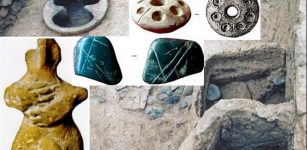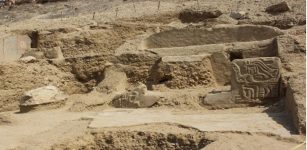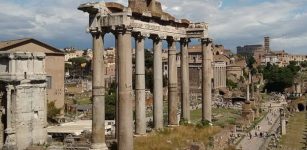War Between Romans And Persians Lasted 721 Years: One Of The World’s Longest Human Conflicts In History
Ellen Lloyd - AncientPages.com - One of the world’s longest human conflicts in history was between the Romans and Persians.
The Hundred Years’ War and even Rome’s long and epic struggle with Carthage was brief compared to Rome and Persia’s Near Eastern struggle. The wars between these great empires lasted about 721 years.
At the beginning of the ancient Roman Empire, the conflicts were only of territorial nature. Ancient Romans used aggressive methods to expand the boundaries of their territories. Later, there came to be a religious aspect to the wars as the Eastern Realm of Christendom confronted the Western bounds of Persian Zoroastrianism.
Tagh-e Kasra as it looked in 1934 in the ancient city of Ctesiphon. Credit: Public Domain
The ancient Roman Empire stretched from Syria to Britain. Only one power could challenge Roman arms on anything approaching an equal footing: the Persian rulers of the land that now comprises Iraq. This area, the location of numerous ancient civilizations, was the heart of a Persian empire stretching from modern Pakistan to the Syrian border. Two dynasties ruled the Persian Empire, the Parthians (238 B.C.–A.D. 227) and later the Sassanids (A.D. 227-651).
Persians had established the capital city of Ctesiphon thirty-five miles from the site of modern Baghdad. As they became great empires during the following centuries, Rome and Persia fought many wars. The Romans attacked Ctesiphon more than a half-dozen times, and on five occasions in the second and third centuries A.D., they took the city by storm.
Roman victories in Iraq were transitory and self-defeating.
Modern reconstruction of Punic Carthage. The circular harbor at the front is the Cothon, the military port of Carthage, where all of Carthage's warships (Biremes) were anchored. Damian Entwistle - CC BY-SA 2.0
Julius Caesar’s planned invasion of Iran through Armenia was cut short by his assassination on the Ides of March in 44 B.C. Mark Antony carried out Caesar’s invasion plan in 36 B.C., without the great military leader’s tactical skill. He lost half his men in the mountains of northwest Iran and marched home through Armenia in the harsh winter.
Emperor Trajan invaded Armenia and Mesopotamia between 114 and 115 and annexed them as Roman provinces. Before sailing downriver to the Persian Gulf, he captured the Parthian capital, Ctesiphon.
Being too old to fight, he later withdrew his armies and returned to Syria. Emperor Trajan died in 117.
".... Drawing on a wealth of new research, archaeologist, historian, and master storyteller Richard Miles resurrects the civilization that ancient Rome struggled so mightily to expunge. This monumental work charts the entirety of Carthage's history, from its origins among the Phoenician settlements of Lebanon to its apotheosis as a Mediterranean empire whose epic land-and-sea clash with Rome made a legend of Hannibal and shaped the course of Western history. Carthage Must Be Destroyed reintroduces readers to the ancient glory of a lost people and their generations-long struggle against an implacable enemy. ..." Read more
The struggles continued between the empires. Finally, a Persian hero arose in the person of Shapur I, the second king of the Sassanid dynasty, whose reign of 241-272. He retook much of the territory Rome had won in previous wars and even made incursions into Roman territory.
He captured Roman Emperor Valerian after crushing his army in A.D. 260, and Khusro II in 611 penetrated the Bosporus, in sight of Constantinople before a Byzantine counterattack drove him and his men back to Iraq. The Sassanid state collapsed not long after the Arab victory at the Battle of Qadesiya in Iraq in 637. Byzantium survived but only after losing Syria, Egypt, Palestine, and northern Africa to the Arabs.
Roman emperor Valerian surrenders to Shapur I. Credit: Ali Ganjei - Public Domain
The conflict between the great empires was a matter of power and glory. For centuries, every ambitious young Roman dreamed of winning a battle and returning home to celebrate a triumph.
A triumph was not merely a victory parade, although the successful general–in a chariot pulled by white horses and with a laurel wreath on his head–would ride through the city of Rome to the cheers of the crowd, accompanied by his troops and with booty and captives on display.
The ostentatious parade was an official recognition by the Roman Senate that the general had won a major victory and that, in effect, he was a man to be reckoned with. For many a Roman noble, the triumphal procession led to the Forum, where political success began.
The devastating effects of these wars were that both empires crippled. Persia was plunged into several years of dynastic turmoil and civil war.
Credit: Adobe Stock - vukkostic
The Roman Empire was also severely affected, with its financial reserves exhausted by the war and the Balkans now largely in the hands of the Slavs.
So, which side won the battle? None, actually. The winners of the conflict between the Romans and Persians were the Arabs. Within a few years, both once great empires were struck by the onslaught of the Arabs who inherited the energy that the two powers wasted on the conflict.
Rarely in the history of human conflict has a feud such as the one between the empires of Rome and Persia lasted so long and accomplished so little.
Written by Ellen Lloyd - AncientPages.com
Copyright © AncientPages.com All rights reserved. This material may not be published, broadcast, rewritten or redistributed in whole or part without the express written permission of AncientPages.com
More From Ancient Pages
-
 Puzzling Ancient Artifacts Of Unknown Origin And Purpose
Artifacts | Mar 10, 2014
Puzzling Ancient Artifacts Of Unknown Origin And Purpose
Artifacts | Mar 10, 2014 -
 Ancient DNA Reveals Missing Link In The History Of Indo-European Languages
Linguistic Discoveries | Feb 5, 2025
Ancient DNA Reveals Missing Link In The History Of Indo-European Languages
Linguistic Discoveries | Feb 5, 2025 -
 Unexpected discovery of hidden color in ancient mummy portraits
News | Aug 27, 2015
Unexpected discovery of hidden color in ancient mummy portraits
News | Aug 27, 2015 -
 Ancient Mystery Of The American Southwest – Unusual Skeletons And Mummies – Part 2
Ancient Mysteries | Jul 24, 2018
Ancient Mystery Of The American Southwest – Unusual Skeletons And Mummies – Part 2
Ancient Mysteries | Jul 24, 2018 -
 Prehistoric Puzzle: Three Gigantic Stone Heads Of Unknown Origin
Featured Stories | Mar 17, 2020
Prehistoric Puzzle: Three Gigantic Stone Heads Of Unknown Origin
Featured Stories | Mar 17, 2020 -
 Fascinating Gigantic Creatures Today Totally Extinct 13,000 Years Ago Co-Existed With Early Americans
Archaeology | May 8, 2012
Fascinating Gigantic Creatures Today Totally Extinct 13,000 Years Ago Co-Existed With Early Americans
Archaeology | May 8, 2012 -
 Another Franklin Expedition Crew Member Identified
Archaeology | Sep 26, 2024
Another Franklin Expedition Crew Member Identified
Archaeology | Sep 26, 2024 -
 Mysterious Prehistoric Statues In Bada Valley, Indonesia Surrounded With Countless Legends
Civilizations | Jan 9, 2019
Mysterious Prehistoric Statues In Bada Valley, Indonesia Surrounded With Countless Legends
Civilizations | Jan 9, 2019 -
 World’s Oldest And Largest Maya Structure Revealed By LIDAR
Archaeology | Jun 9, 2020
World’s Oldest And Largest Maya Structure Revealed By LIDAR
Archaeology | Jun 9, 2020 -
 Chilean Mummies Clad In Red Poison Dresses – Evidence Of A Unique Inca Ritual
Archaeology | Jul 28, 2018
Chilean Mummies Clad In Red Poison Dresses – Evidence Of A Unique Inca Ritual
Archaeology | Jul 28, 2018 -
 Ancient History Of Dentistry
Featured Stories | Jun 22, 2018
Ancient History Of Dentistry
Featured Stories | Jun 22, 2018 -
 Shengavit Of Kura Araxes Culture: One Of Armenia’s Historical Sites Inhabited Since At Least 3200 BC
Civilizations | Apr 13, 2021
Shengavit Of Kura Araxes Culture: One Of Armenia’s Historical Sites Inhabited Since At Least 3200 BC
Civilizations | Apr 13, 2021 -
 Archaeological Evidence Ancient Egyptians Visited South America
Ancient Mysteries | Jan 7, 2020
Archaeological Evidence Ancient Egyptians Visited South America
Ancient Mysteries | Jan 7, 2020 -
 Pre-Inca Temple With Colored Paintings And Carved Sculptures Discovered At The Los Paredones Archaeological Complex, Peru
Archaeology | Jul 8, 2024
Pre-Inca Temple With Colored Paintings And Carved Sculptures Discovered At The Los Paredones Archaeological Complex, Peru
Archaeology | Jul 8, 2024 -
 Unique 1,600-Year-Old Gold Bead Found By Teenager In Jerusalem’s City Of David
Archaeology | Feb 9, 2023
Unique 1,600-Year-Old Gold Bead Found By Teenager In Jerusalem’s City Of David
Archaeology | Feb 9, 2023 -
 Mysterious Valkyrie Eir Remains An Enigma In Norse Mythology
Featured Stories | Apr 4, 2018
Mysterious Valkyrie Eir Remains An Enigma In Norse Mythology
Featured Stories | Apr 4, 2018 -
 On This Day In History: Myth Says Ancient Rome Was Founded By Romulus – On Apr 21, 753 BC
News | Apr 21, 2016
On This Day In History: Myth Says Ancient Rome Was Founded By Romulus – On Apr 21, 753 BC
News | Apr 21, 2016 -
 Accelerated Bone Deterioration At Mesolithic Peat Bog In Ageröd, Sweden
Archaeology | Aug 4, 2020
Accelerated Bone Deterioration At Mesolithic Peat Bog In Ageröd, Sweden
Archaeology | Aug 4, 2020 -
 How Can Busy People Also Keep Fit And Healthy? What The Ancient Greeks And Romans Did?
Featured Stories | Jul 16, 2024
How Can Busy People Also Keep Fit And Healthy? What The Ancient Greeks And Romans Did?
Featured Stories | Jul 16, 2024 -
 Oldest Giant Dinosaur Species Discovered In Argentina
Archaeology | Jul 10, 2018
Oldest Giant Dinosaur Species Discovered In Argentina
Archaeology | Jul 10, 2018





